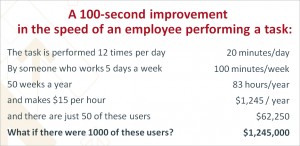A common rule of thumb in the user experience field is, “Pay attention to what users do, not what they say.” With customizable portals, users will often say that they would put the effort into configuring their own experience. In practice, however, most do not take the time to do so. The Nielsen Norman Group, a worldwide leader in user research, found that, “People very rarely use corporate portal customizations, however much they ask for them.” They found that role-based personalization—where a customized experience is created for the user based on information already known about them—is the best approach to creating an optimized portal user experience.
In a recent usability test on a portal site, I asked users whether they would like to customize their experience for the site. While most of them said they would, in a follow-up question asking whether they have customized their experiences on other public or work-related portals, they said they did not. So, what people say they want or will do does not typically match to what they actually do. User-centered analysis, design, and testing focuses in on providing the experience that most closely matches to what users do.
A very common challenge to portal user experience is single sign-on. While most portals aim for this goal, often it is not achieved. Modeling user task flows across portlets can help to identify multiple sign-on points and determine the best ways to at least reduce the number of sign-ons required for an individual user on a regular basis. Other interface design principles can help communicate these requirements to users and address concerns that might otherwise to go a help desk.
With portal solutions, a paramount concern for the user experience is providing as seamless an experience as possible, so that users see common visual themes, use interaction controls that work the same way wherever they are, and are able to navigate successfully to any part of the portal without getting lost. When pulling together data from multiple sources and often from multiple contributors, it can be tricky to maintain a consistent experience. User experience tools and methods aim to keep the focus on that overall experience while still meeting important business goals. The approach also reveals which features aren’t as important to the user’s goals, helping to streamline efforts and priorities.


Pingback: conversion pound dollars